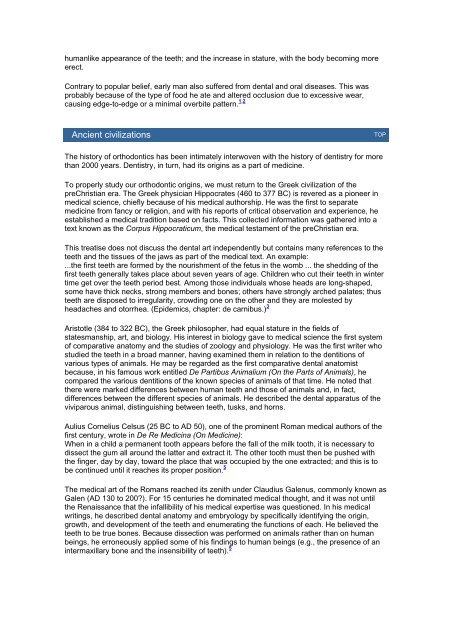A brief history of orthodontics - ortodontia e ortopedia facial
A brief history of orthodontics - ortodontia e ortopedia facial
A brief history of orthodontics - ortodontia e ortopedia facial
You also want an ePaper? Increase the reach of your titles
YUMPU automatically turns print PDFs into web optimized ePapers that Google loves.
humanlike appearance <strong>of</strong> the teeth; and the increase in stature, with the body becoming more<br />
erect.<br />
Contrary to popular belief, early man also suffered from dental and oral diseases. This was<br />
probably because <strong>of</strong> the type <strong>of</strong> food he ate and altered occlusion due to excessive wear,<br />
causing edge-to-edge or a minimal overbite pattern. 1,2<br />
Ancient civilizations TOP<br />
The <strong>history</strong> <strong>of</strong> <strong>orthodontics</strong> has been intimately interwoven with the <strong>history</strong> <strong>of</strong> dentistry for more<br />
than 2000 years. Dentistry, in turn, had its origins as a part <strong>of</strong> medicine.<br />
To properly study our orthodontic origins, we must return to the Greek civilization <strong>of</strong> the<br />
preChristian era. The Greek physician Hippocrates (460 to 377 BC) is revered as a pioneer in<br />
medical science, chiefly because <strong>of</strong> his medical authorship. He was the first to separate<br />
medicine from fancy or religion, and with his reports <strong>of</strong> critical observation and experience, he<br />
established a medical tradition based on facts. This collected information was gathered into a<br />
text known as the Corpus Hippocraticum, the medical testament <strong>of</strong> the preChristian era.<br />
This treatise does not discuss the dental art independently but contains many references to the<br />
teeth and the tissues <strong>of</strong> the jaws as part <strong>of</strong> the medical text. An example:<br />
...the first teeth are formed by the nourishment <strong>of</strong> the fetus in the womb ... the shedding <strong>of</strong> the<br />
first teeth generally takes place about seven years <strong>of</strong> age. Children who cut their teeth in winter<br />
time get over the teeth period best. Among those individuals whose heads are long-shaped,<br />
some have thick necks, strong members and bones; others have strongly arched palates; thus<br />
teeth are disposed to irregularity, crowding one on the other and they are molested by<br />
headaches and otorrhea. (Epidemics, chapter: de carnibus.) 3<br />
Aristotle (384 to 322 BC), the Greek philosopher, had equal stature in the fields <strong>of</strong><br />
statesmanship, art, and biology. His interest in biology gave to medical science the first system<br />
<strong>of</strong> comparative anatomy and the studies <strong>of</strong> zoology and physiology. He was the first writer who<br />
studied the teeth in a broad manner, having examined them in relation to the dentitions <strong>of</strong><br />
various types <strong>of</strong> animals. He may be regarded as the first comparative dental anatomist<br />
because, in his famous work entitled De Partibus Animalium (On the Parts <strong>of</strong> Animals), he<br />
compared the various dentitions <strong>of</strong> the known species <strong>of</strong> animals <strong>of</strong> that time. He noted that<br />
there were marked differences between human teeth and those <strong>of</strong> animals and, in fact,<br />
differences between the different species <strong>of</strong> animals. He described the dental apparatus <strong>of</strong> the<br />
viviparous animal, distinguishing between teeth, tusks, and horns.<br />
Aulius Cornelius Celsus (25 BC to AD 50), one <strong>of</strong> the prominent Roman medical authors <strong>of</strong> the<br />
first century, wrote in De Re Medicina (On Medicine):<br />
When in a child a permanent tooth appears before the fall <strong>of</strong> the milk tooth, it is necessary to<br />
dissect the gum all around the latter and extract it. The other tooth must then be pushed with<br />
the finger, day by day, toward the place that was occupied by the one extracted; and this is to<br />
be continued until it reaches its proper position. 5<br />
The medical art <strong>of</strong> the Romans reached its zenith under Claudius Galenus, commonly known as<br />
Galen (AD 130 to 200?). For 15 centuries he dominated medical thought, and it was not until<br />
the Renaissance that the infallibility <strong>of</strong> his medical expertise was questioned. In his medical<br />
writings, he described dental anatomy and embryology by specifically identifying the origin,<br />
growth, and development <strong>of</strong> the teeth and enumerating the functions <strong>of</strong> each. He believed the<br />
teeth to be true bones. Because dissection was performed on animals rather than on human<br />
beings, he erroneously applied some <strong>of</strong> his findings to human beings (e.g., the presence <strong>of</strong> an<br />
intermaxillary bone and the insensibility <strong>of</strong> teeth). 5


